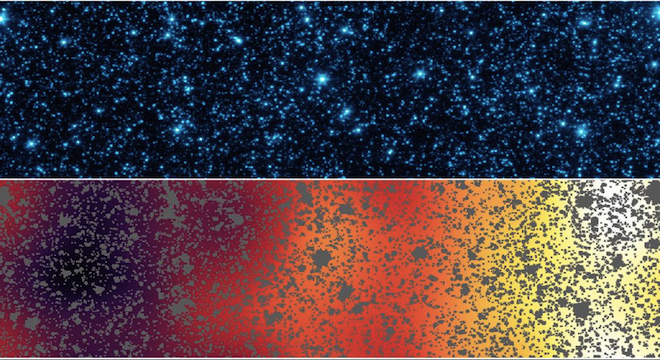NASA scientists have isolated an ethereal glow permeating parts of the sky that may be the remnants of the earliest objects in the universe.
The glow, which is seen as the red and orange glow in the NASA image at the top of this article, is thought to be from the first stars that formed in the universe, some 13 billion years ago, shortly after the theorized “Big Bang” some 13.7 billion years ago.
“All we can say is that these sources do not exist among the known galaxy populations, which have been observed to very early times (large distances),” said Alexander “Sasha” Kashlinsky, a NASA scientist who led the team that made the discovery, in an email to TPM. “This likely puts us within the first half-giga-year of the universe’s evolution, the epoch of first stars.”
The glow was first detected in 2005 by NASA’s Spitzer Space Telescope, but scientists weren’t able to fully isolate it from the brighter glow of stars and galaxies until recently, when they were allowed to point the Spitzer at a region of interest in the sky — near the constellation Boötes — and study it for over 400 hours.
“It is not unlike looking at an old TV set, where the noise and resolution of each pixel are poor,” Kashlinksy added. “In this measurement we have to isolate a very faint signal, so the most challenging task was map-making.”
Fortunately, the Spitzer Space Telescope was the exact right tool for the job: The telescope, which is currently in orbit around the Sun, following behind Earth, was at the time of its launch in 2003 the largest infrared telescope ever launched into space (The European Space Agency’s Herschel has since succeeded it).
Spitzer’s infrared array camera “has the right wavelengths range for probing the (redshifted) emissions from these early populations, good angular resolution for isolating and removing known intervening galaxies, and sufficiently wide field-of-view for probing the remaining structure on large scales,” Kashlinksy explained.
That said, due to Spitzer’s shorter-wavelength view, scientists still aren’t sure exactly what the early objects that caused the glow were or are — stars, black holes, galaxies or some previously unknown celestial formation.
“The measurements we have done with Spitzer cannot unambiguously answer this,” Kashlinsky told TPM.
In order to discern the precise origin of the glow, astronomers will have to turn to instruments with wavelengths different from those of Spitzer.
“We hope to achieve this in the coming years (or months),” Kashlinsky said.
Ideally, the forthcoming James Webb Space Telescope, which is now under construction for a planned 2018 launch date, will be able to trace the faint light of the earliest structures back to their source. But the project has been beset by delays, ballooning costs and budget-cutting legislators.
Still, for now, his team is elated with the results, which are set to be published in a new paper in The Astrophysical Journal.
“This opens a window to the epochs of universe’s history inaccessible by other means and which will remain inaccessible for many years to come,” Kashlinksy told TPM. “With these measurements, we can learn about the activity, abundances and nature of the first sources of light in the Universe, which has been a subject of great theoretical activity, but only limited empirical evidence.”
Correction: This article originally misspelled “Big Bang” as “Bing Bang.” The error has since been corrected in copy and we regret it.






